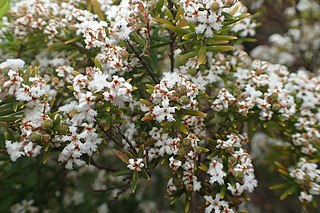
Leucopogon rubricaulis is a species of flowering plant in the heath family Ericaceae and is endemic to the south of Western Australia. It is an erect, open shrub with narrowly egg-shaped or narrowly elliptic leaves and white, tube-shaped flowers arranged on the ends of branches and in upper leaf axils in groups of four to thirteen.

Leucopogon obovatus is a species of flowering plant in the heath family Ericaceae and is endemic to the southwest of Western Australia. It is an erect shrub with hairy young branchlets, variably-shaped, simple leaves, and erect clusters of 3 to 15 white, bell-shaped flowers on the ends of branches and in upper leaf axils.
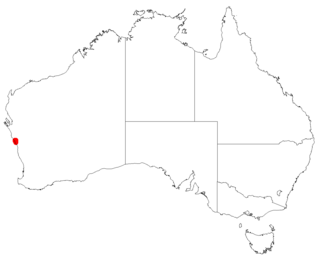
Leucopogon borealis is a species of flowering plant in the heath family Ericaceae and is endemic to a restricted area of the west of Western Australia. It is an erect shrub with hairy young branchlets, linear leaves and white flowers in nine to twenty upper leaf axils.
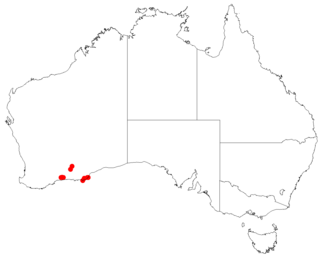
Leucopogon bossiaea is a species of flowering plant in the heath family Ericaceae and is endemic to a restricted area in the south-west of Western Australia. It is an erect shrub with elliptic to broadly egg-shaped leaves and white flowers in four to eleven upper leaf axils.
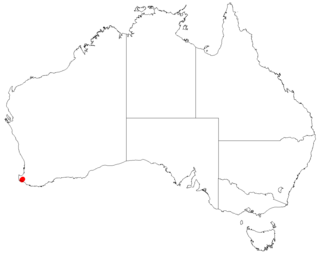
Leucopogon incisus is a species of flowering plant in the heath family Ericaceae and is endemic to a small area in the far south of the south-west of Western Australia. It is a delicate, erect or sprawling shrub with glabrous young branchlets, spirally arranged, erect, narrowly egg-shaped to narrowly elliptic leaves, and white or pale pink, narrowly bell-shaped to more or less cylindrical flowers.

Leucopogon inflexus is a species of flowering plant in the heath family Ericaceae and is endemic to the south-west of Western Australia. It is an erect, open shrub with more or less glabrous young branchlets, spirally arranged, erect, egg-shaped to more or less round leaves, and white, bell-shaped, densely bearded flowers.
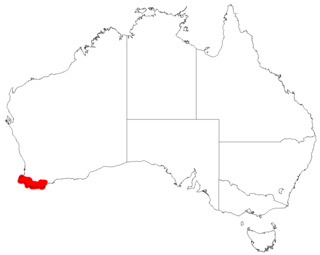
Leucopogon interstans is a species of flowering plant in the heath family Ericaceae and is endemic to the south-west of Western Australia. It is an erect shrub with brownish hairs on its young branchlets, erect, narrowly elliptic or narrowly egg-shaped leaves and white or pinkish flowers in groups in upper leaf axils or on the ends of branches.
Conostephium laeve is a species of flowering plant in the family Ericaceae and is endemic to the west of Western Australia. It is a compact shrub with erect, narrowly elliptic or narrowly egg-shaped leaves with the narrower end toward the base, and pendulous, spindle-shaped, cream to straw-coloured and pink flowers.
Conostephium papillosum is a species of flowering plant in the family Ericaceae and is endemic to the south of Western Australia. It is a compact shrub with erect, narrowly elliptic or narrowly egg-shaped leaves with the narrower end toward the base, and pendulous, spindle-shaped, cream to straw-coloured and dark purple flowers.

Leucopogon maritimus is a species of flowering plant in the heath family Ericaceae and is endemic to the west coast of Western Australia. It is a low, spreading shrub with hairy young branchlets, erect, narrowly elliptic leaves and erect white, tube-shaped flowers in upper leaf axils or on the ends of branches.
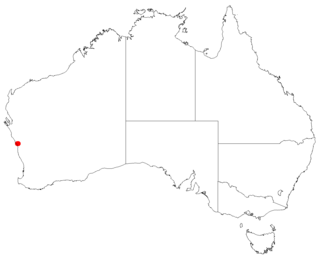
Leucopogon navicularis is a species of flowering plant in the heath family Ericaceae and is endemic to the southwest of Western Australia. It is an erect, compact shrub with hairy young branchlets, narrowly elliptic to narrowly egg-shaped leaves and erect, compact clusters of 4 to 12 white, bell-shaped flowers in upper leaf axils or on the ends of branches.
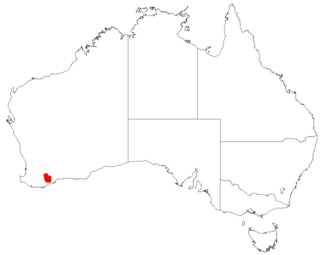
Leucopogon newbeyi is a species of flowering plant in the heath family Ericaceae and is endemic to a small area in the southwest of Western Australia. It is an erect shrub with densely hairy young branchlets, linear to narrowly elliptic or narrowly egg-shaped leaves and erect, compact clusters of 7 to 17 white, bell-shaped flowers mainly on the ends of branches.

Leucopogon spectabilis is a species of flowering plant in the heath family Ericaceae and is endemic to inland Western Australia. It is a narrow, erect shrub with few glabrous branchlets, narrowly elliptic leaves and relatively large white flowers arranged in 14 to 32 upper leaf axils.
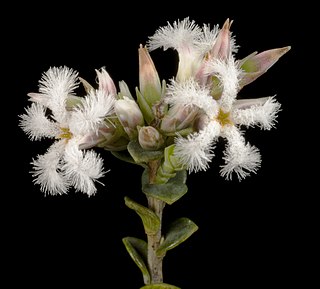
Leucopogon squarrosus is a species of flowering plant in the heath family Ericaceae and is endemic to the southwest of Western Australia. It is an erect shrub with hairy young branchlets, egg-shaped or elliptic leaves and dense, erect clusters of 5 to 14 white flowers on the ends of branches and in upper leaf axils.

Leucopogon stenophyllus is a species of flowering plant in the heath family Ericaceae and is endemic to the south-west of Western Australia. It is an erect, open shrub with a single stem at ground level, linear, narrowly egg-shaped or narrowly elliptic leaves and erect clusters of 3 to 17 white flowers on the ends of branches and short side-branches.

Leucopogon stokesii is a species of flowering plant in the heath family Ericaceae and is endemic to a small area in the south-west of Western Australia. It is an erect, open shrub with hairy young branchlets, narrowly elliptic leaves and erect, dense clusters of 5 to 10 bell-shaped white flowers on the ends of branches.

Styphelia capillaris, commonly known as Horts' styphelia, is a species of flowering plant in the heath family Ericaceae and is endemic to a small area of south-western Western Australia. It is a dense, spreading shrub with narrowly egg-shaped to narrowly elliptic leaves and white flowers arranged singly or in pairs in leaf axils.
Styphelia angustiflora is a species of flowering plant in the heath family Ericaceae and is endemic to a small area near York, in the south-west of Western Australia. It is an erect, compact shrub with sharply-pointed, narrowly egg-shaped leaves and white, tube-shaped flowers.
Styphelia cernua is a species of flowering plant in the heath family Ericaceae and is endemic to a small area of Western Australia. It is an erect shrub with narrowly egg-shaped leaves with the narrower end towards the base, and white flowers arranged singly or in pairs in leaf axils.
Styphelia chlorantha is a species of flowering plant in the heath family Ericaceae and is endemic to a small area of Western Australia. It is a low, spreading shrub with erect, narrowly egg-shaped to egg-shaped leaves with the narrower end towards the base, and green, tube-shaped flowers arranged singly in leaf axils.















